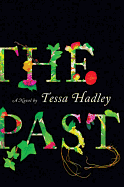
 The intricacies and hierarchies--often the competitive nature--of the family dynamic are central to the fiction of Tessa Hadley (Clever Girl). In her sixth novel, The Past, four middle-aged siblings reunite at the 200-year-old house they inherited from their grandparents, tucked amid the hills of the English countryside in Kington.
The intricacies and hierarchies--often the competitive nature--of the family dynamic are central to the fiction of Tessa Hadley (Clever Girl). In her sixth novel, The Past, four middle-aged siblings reunite at the 200-year-old house they inherited from their grandparents, tucked amid the hills of the English countryside in Kington.
The house is "mottled with brown damp, there was no central heating and the roof leaked." It is situated near another cottage and a church, where the family's grandfather, a famous poet, was once minister. The siblings and their significant others have gathered for a three-week summer visit to decide whether to put the old place on the market. The house "seemed to be a vision of another world, its stillness pregnant with meaning, like a room seen in a mirror." But once the siblings convene, their old home, all it represented in the past, and how it relates to their lives in the present--along with simmering familial tensions--collide.
Harriet, the oldest--a nature lover, once a revolutionary and now working for social justice--is a shy loner in search of solitude. Alice, the middle sister, is a "frivolous," often scatterbrained, free spirit who brings along Kasim, a moody college freshman and the son of one of her old flames. Fran, the youngest, a pragmatic math teacher, travels with her two children: Ivy, an imaginative nine-year-old and Arthur, age six. Fran's husband, an actor, is a no-show. And Roland, a philosophy professor, arrives with his third wife, Pilar, an Argentinean lawyer, along with his 16-year-old daughter, Molly, from a prior marriage.
The seemingly restful setting proves otherwise as the group is besieged by rainy days, spotty wi-fi and the foibles and limitations of themselves and each other. Amid an unhurried plot, the two young children stumble upon a dead dog and a stash of pornography, Kasim tries to woo Molly, and they all eventually get on each other's nerves. Emotions and old rivalries flare as the sisters initially refuse to accept Pilar. Not everyone has a desire to revisit and romanticize the past or stir memories of the house; it was a refuge for the young siblings in 1968, when their mother, now deceased, left their philandering father.
Hadley's prose is descriptively rich. She elevates the mundane via her keen understanding of people and the emotional complexities of marriages and families--secrets, subtle deceptions and loyalties. By structuring the novel in three parts--a flashback from 1968, set between two sections steeped in the present--Hadley contrasts ideas about age and youth, the past and present, solace and aggravation, love and resentment. The idea that, in families, siblings emerge from the same roots and same place, but eventually splinter off in different directions is at the heart of this tender, understated novel. It examines how we never really escape the upheavals of the past; they seep into our being. --Kathleen Gerard, blogger at Reading Between the Lines
Shelf Talker: Four adult siblings and their significant others reunite for three weeks in the English countryside to decide the fate of an inherited old house.

